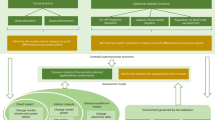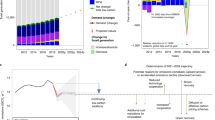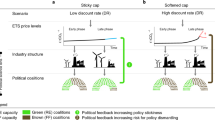Abstract
China began implementing market-based economic dispatch through power sector reform in 2015, but the reform has encountered some political and economic challenges. Here we identify the reform’s efficiency changes and explore the influences of market-driven and politically driven mechanisms behind them. We do this through a cost-minimizing dispatch model integrating high-frequency data in southern China. We find that the dispatch transition improves the overall efficiency, but regulatory capture in provincial markets limits its full potential. The preference for local enterprises over central state-owned enterprises (SOEs) by local governments, in the form of allocated generation quotas, demonstrates the political challenge for market reform. The allocated generation quota protects small coal-fired and natural gas generators owned by local SOEs, lessening their motivation to improve generation efficiency, even after the reform. As a result, nearly half of the potential carbon dioxide emissions reduction and social welfare gains through market reform is not realized.
This is a preview of subscription content, access via your institution
Access options
Access Nature and 54 other Nature Portfolio journals
Get Nature+, our best-value online-access subscription
$29.99 / 30 days
cancel any time
Subscribe to this journal
Receive 12 digital issues and online access to articles
$119.00 per year
only $9.92 per issue
Buy this article
- Purchase on Springer Link
- Instant access to full article PDF
Prices may be subject to local taxes which are calculated during checkout






Similar content being viewed by others
Data availability
The unit-level data and high-frequency data used during the current study were obtained under a confidentiality agreement and hence cannot be made publicly available. Other data are available from the corresponding author on reasonable request.
Code availability
Requests for the code developed and annotated in Stata (Version 15) and Matlab (Version R2016a) to process and analyse the primary data will be reviewed and made available upon reasonable request.
Change history
10 August 2023
A Correction to this paper has been published: https://doi.org/10.1038/s41560-023-01353-1
References
Davidson, M. R., Zhang, D., Xiong, W., Zhang, X. & Karplus, V. J. Modelling the potential for wind energy integration on China’s coal-heavy electricity grid. Nat. Energy 1, 16086 (2016).
Statistical Review of World Energy (BP, 2021); http://www.bp.com/statisticalreview
China Energy Statistical Yearbook (National Bureau of Statistics, 2020).
Pathways and Policy for Peaking CO2 Emissions in China’s Power Sector (Institute of Energy of Peking University, 2021); https://energy.pku.edu.cn/index.htm
Kahrl, F., Williams, J., Jianhua, D. & Junfeng, H. Challenges to China’s transition to a low carbon electricity system. Energy Policy 39, 4032–4041 (2011).
Kahrl, F., Williams, J. H. & Hu, J. The political economy of electricity dispatch reform in China. Energy Policy 53, 361–369 (2013).
Dupuy, M. China Power Sector Reform: Key Issues for the World’s Largest Power Sector (Regulatory Assistance Project, 2016).
Pollitt, M., Yang, C.-H. & Chen, H. Reforming the Chinese Electricity Supply Sector: Lessons from International Experience (Energy Policy Research Group, 2017); http://www.eprg.group.cam.ac.uk/
Gallagher, K. S. et al. Assessing the policy gaps for achieving China’s climate targets in the Paris Agreement. Nat. Commun. 10, 1256 (2019).
Lynch, M. Á., Shortt, A., Tol, R. S. & O’Malley, M. J. Risk–return incentives in liberalized electricity markets. Energy Econ. 40, 598–608 (2013).
Bistline, J. E. Electric sector capacity planning under uncertainty: climate policy and natural gas in the US. Energy Econ. 51, 236–251 (2015).
Hu, Y. & Cheng, H. Displacement efficiency of alternative energy and trans-provincial imported electricity in China. Nat. Commun. 8, 14590 (2017).
Duan, L. et al. Stylized least-cost analysis of flexible nuclear power in deeply decarbonized electricity systems considering wind and solar resources worldwide. Nat. Energy 7, 260–269 (2022).
Nikolakakis, T., Chattopadhyay, D. & Bazilian, M. A review of renewable investment and power system operational issues in Bangladesh. Renew. Sustain. Energy Rev. 68, 650–658 (2017).
Abhyankar, N., Lin, J., Liu, X. & Sifuentes, F. Economic and environmental benefits of market-based power-system reform in China: a case study of the Southern grid system. Resour. Conserv. Recycl. 153, 104558 (2020).
Naughton, B. in How Far Across the River?: Chinese Policy Reform at the Millennium (eds Hope, N. C. et al.) 204–232 (Stanford Univ. Press, 2003).
Wei, C. & Zheng, X. Y. A new perspective on energy efficiency enhancement: a test based on market segmentation. Soc. Sci. China 10, 90–111 (2017).
Wei, Y.-M. et al. Economic dispatch savings in the coal-fired power sector: an empirical study of China. Energy Econ. 74, 330–342 (2018).
Stigler, G. J. The theory of economic regulation. Bell J. Econ. Manag. Sci. 2, 3–21 (1971).
Zhong, H., Xia, Q., Chen, Y. & Kang, C. Energy-saving generation dispatch toward a sustainable electric power industry in China. Energy Policy 83, 14–25 (2015).
Global Coal Plant Tracker (Global Energy Monitor, 2022); https://globalenergymonitor.org/projects/global-coal-plant-tracker/
Statistics of Electric Power Industry (China Electricity Council, 2015).
Bugge, J., Kjær, S. & Blum, R. High-efficiency coal-fired power plants development and perspectives. Energy 31, 1437–1445 (2006).
Yu, F., Chen, J., Sun, F., Zeng, S. & Wang, C. Trend of technology innovation in China’s coal-fired electricity industry under resource and environmental constraints. Energy Policy 39, 1586–1599 (2011).
Bai, C., Du, Y., Tao, Z. & Tong, Y. Local protectionism and industrial concentration in China: overall trend and important factors. Econ. Res. J. 4, 29–40 (2004).
Lin, J., Kahrl, F., Yuan, J., Liu, X. & Zhang, W. Challenges and strategies for electricity market transition in China. Energy Policy 133, 110899 (2019).
Cicala, S. When does regulation distort costs? Lessons from fuel procurement in US electricity generation. Am. Econ. Rev. 105, 411–444 (2015).
Fang, M. Innate advantages or hard work—an empirical study of the impacts of SOEs administrative level on total factor productivity. Finance Trade Econ. 11, 125–136 (2014).
Chen, H., Cui, J., Song, F. & Jiang, Z. Evaluating the impacts of reforming and integrating China’s electricity sector. Energy Econ. 108, 105912 (2022).
Sasse, J. P. & Trutnevyte, E. Regional impacts of electricity system transition in Central Europe until 2035. Nat. Commun. 11, 4972 (2020).
Lin, J., Kahrl, F., Yuan, J., Chen, Q. & Liu, X. Economic and carbon emission impacts of electricity market transition in China: a case study of Guangdong Province. Appl. Energy 238, 1093–1107 (2019).
Zhuo, Z. et al. Cost increase in the electricity supply to achieve carbon neutrality in China. Nat. Commun. 13, 3172 (2022).
Chen, H., Chyong, C. K., Mi, Z. & Wei, Y. M. Reforming the operation mechanism of Chinese electricity system: benefits, challenges and possible solutions. Energy J. 41, 192–217 (2020).
Chan, H. S., Cropper, M. L. & Malik, K. Why are power plants in India less efficient than power plants in the United States?. Am. Econ. Rev. 104, 586–590 (2014).
Li, J. & Ho, M. Indirect cost of renewable energy: insights from dispatching. Energy Econ. 105, 105778 (2022).
China Southern Power Grid Dispatch Annual Report 2010–2018 (China Southern Power Grid Dispatching and Control Center, 2019).
National Enterprise Credit Information Publicity System (State Administration for Market Regulation of China, 2023); https://www.gsxt.gov.cn/index.html
Brandt, L., Van Biesebroeck, J. & Zhang, Y. Challenges of working with the Chinese NBS firm-level data. China Econ. Rev. 30, 339–352 (2014).
Acknowledgements
This work is supported by the National Natural Science Foundation of China (20211GZ0113). We thank H. Chen and J. Cui for the model discussion from an economic perspective. We are grateful to Q.-F. Meng for the model discussion from a mathematical perspective.
Author information
Authors and Affiliations
Contributions
C.X., X.Z., J.L. and F.S. designed the study. X.Z., F.S. and Z.J. supported the data collection. C.X. performed the modelling, carried out the analysis and drafted the paper. J.L. supervised the work, co-wrote the paper and provided policy recommendations. All authors reviewed the paper.
Corresponding author
Ethics declarations
Competing interests
The authors declare no competing interests.
Peer review
Peer review information
Nature Energy thanks Da Zhang and the other, anonymous, reviewer(s) for their contribution to the peer review of this work.
Additional information
Publisher’s note Springer Nature remains neutral with regard to jurisdictional claims in published maps and institutional affiliations.
Supplementary information
Supplementary Information
Supplementary Notes 1–3, Tables 1–7, Figs. 1–3 and References.
Rights and permissions
About this article
Cite this article
Xiang, C., Zheng, X., Song, F. et al. Assessing the roles of efficient market versus regulatory capture in China’s power market reform. Nat Energy 8, 747–757 (2023). https://doi.org/10.1038/s41560-023-01278-9
Received:
Accepted:
Published:
Issue Date:
DOI: https://doi.org/10.1038/s41560-023-01278-9
This article is cited by
-
Tensions between local interests and broader gains
Nature Energy (2023)



